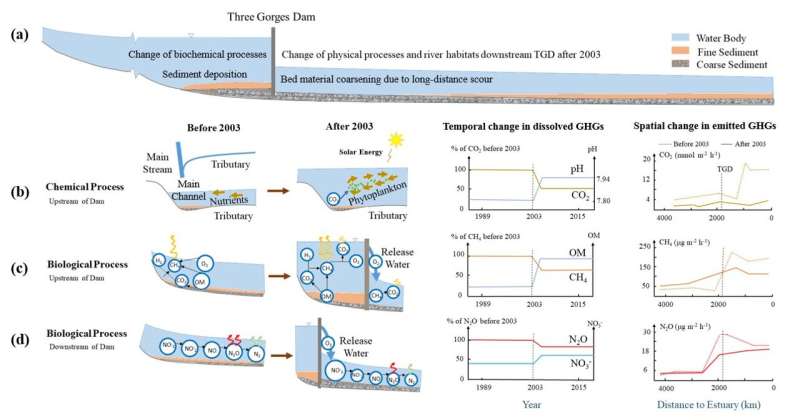Panoramic view of the Three Gorges Dam on the Yangtze River, China. Credit: Science China Press
Dams are conventionally regarded as emitters of GHGs in large rivers. A team from Peking University of China, however, has disrupted this perception, based on whole system thinking applied to the Three Gorges Dam (TGD) on the Yangtze River in China.
This study is led by Professor Jinren Ni. "We spent over eight years to complete this work," Ni says. The team used 30 water quality indices for 25 years and measured greenhouse gases (GHGs) along 4,300 km of the Yangtze River. Huge datasets and data-driven models were established using machine learning tools for riverine greenhouse gases. This revealed the effect of initial emission of GHGs on pristine river ecosystems and provided a reliable methodology for robust assessment of the change in GHGs induced by dams.
Since commencing operation in 2003, the TGD has altered carbonate equilibrium in the reservoir area, enhanced methanogenesis in the upstream, but restrained methanogenesis and denitrification via modifying anoxic habitats through long-distance scouring in the downstream. It is necessary to include both the upstream and downstream reaches, when examining the spatiotemporal scope of "large-dam effects" of the TGD.
A quantitative division was discovered between new emissions resulting from impoundment and operation of the TGD and pristine emissions that occurred naturally before its construction. This leads to an unexpected finding that the TGD has caused considerable reductions in the annual average emissions of CO2, CH4, and N2O in the Yangtze River. Using a whole-system approach, the team finds that the impact of TGD extends thousands of kilometers downstream along the Yangtze River, far beyond the reservoir and its immediate surroundings (with only the latter considered in most previous studies). "Their approach is based on the logic that a full accounting of GHG consequences of the dam should encompass the full sphere of the dam's influence. This methodology led to the result that aquatic emissions have declined rather than increased since the dam went into operation," says Professor Emily Stanley from University of Wisconsin-Madison.
Whole system analysis concerning readjustment of physical and biogeochemical equilibria involved in regulation effects of the Three Gorges Dam on GHGs emissions from the Yangtze River, China. Credit: Science China Press
As a clean energy source, hydropower can help to reduce dependence on traditional fossil fuel energy (such as coal, oil, and natural gas) and significantly reduce GHGs emissions. In recent years, some researchers suggested that dams would increase GHGs emissions from rivers. This issue received renewed attention, stimulating much debate on changes in GHGs emissions before and after TGD operation. By providing a panoramic view of CO2, CH4, and N2O fluxes along the Yangtze River, the present study helps settle the debate on GHGs induced by large dams. According to Professor Ni, "this means that the TGD facilitate the reduction of GHGs emissions, even when leaving aside the huge benefits of GHGs reduction from fossil fuel substitution by hydropower."
Whole system analysis provides new insights into GHGs emissions caused by the operation of large dams, which are essential prerequisites in understanding their implications for the biogeochemical cycles of large rivers. As Professor Stanley notes, "Although TGD is unique in its size, it is unlikely to be unique in the scale and scope of its influence."
More information: Jinren Ni et al, Three Gorges Dam: friend or foe of riverine greenhouse gases?, National Science Review (2022). DOI: 10.1093/nsr/nwac013
Provided by Science China Press

























